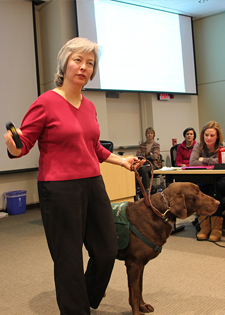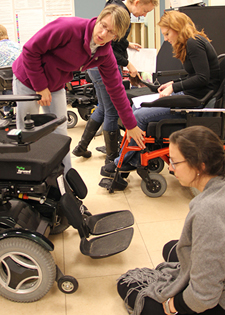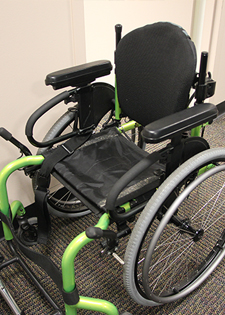Rehabilitation and Participation Science
Program in Occupational Therapy

Students in the “Supporting Participation with Technology and Environmental Interventions” class are learning just how broad the definition of “assistive technology” really is.
“We cover all areas of assistive technology, which includes manual and power wheelchairs, scooters, augmentative communication systems, switches children use to access toys, recreation devices, assistance dogs, vehicle adaptation … you name it,” says Kerri Morgan, MSOT, OTR/L, ATP, the instructor for the class. “Any type of technology that can help someone do something more independently – driving, using a computer, communication, moving around – we want our students to know about it so they will be aware of the options and resources they have as OTs.”
One of those resources Morgan utilizes herself is that of assistive dogs. Her dog, Twix, was trained by C.H.A.M.P. Assistance Dogs, Inc., a not-for-profit that places dogs free of charge to qualifying individuals in the greater St. Louis metropolitan area. C.H.A.M.P. volunteers Nola Ewers and Dianne Peters recently gave a presentation to the class on service animals.
“We enjoy coming out and talking to the students about our service dog program because some day in their future careers, they may encounter someone who might be a candidate for a service dog,” says Ewers. “We want them to have basic understanding of what a service dog may be able to assist someone with and what the criteria are for placement.”
C.H.A.M.P. also trains therapy dogs like Dolly, who works with Regina Abel, PhD, a staff scientist in the Program of Occupational Therapy. Abel recently received IRB approval to conduct a study of patients with psychiatric and rehabilitation issues to gather evidence of the therapeutic effect of Animal Assisted Therapy (AAT).
“As researchers, we all want evidence-based medicine but the challenge has been most therapy dog groups consist of all volunteers. It took some time to arrange the setting in which to collect data for the study,” says Abel. “We will be giving each participant a mood assessment, have them visit with a therapy dog for 10 minutes, then give the assessment again. When you work with a therapy dog, you know they are having an effect. Now, we want to measure it.”
 The class also provides a variety of hands-on lab experiences with a broad range of tools in context-specific personal, community and organizational settings. The students recently visited the Disability and Community Participation Research Office (DACPRO) to learn about the different types of wheelchair technologies and what person-specific modifications can be made to the device.
The class also provides a variety of hands-on lab experiences with a broad range of tools in context-specific personal, community and organizational settings. The students recently visited the Disability and Community Participation Research Office (DACPRO) to learn about the different types of wheelchair technologies and what person-specific modifications can be made to the device.
“We look at what movement the person can control the best and use it to drive the chair,” explains Sue Tucker, MSOT, OTR/L, ATP. “For example, there are a variety of mouth controls, such as a sip and puff, that can be used to power the chair. Other options include joysticks, touchpads and even apps for mobile devices. The only option not currently available is eye control but it is under development.”
The pediatric seating and mobility lab introduces students to the different mobility devices available for children with needs, ranging from wheelchairs and walkers to bathers and cribs. The lab helped dispel the notion that pediatric mobility devices are just a smaller version of their adult counterpart.
“I learned a lot about how the chairs are designed to address the children’s specific needs and skills that just wouldn’t work with a ‘mini version’ of the adult device,” says Kimmy Nguyen, MSOT/S ’14. “An OT’s expertise is needed to ensure that the device is the best fit for that child. The OT is responsible for evaluating the child’s mobile abilities, tone and reflex, environment, school demands, occupations and activities, among many other things.”
 Students learned about the possible emotions that parents may experience while obtaining a device for their child, as they may also be learning to transition. Jan Clarke, RN, ATP, who works for Numotion, described situations where parents had difficulty accepting devices such as a wheelchair because to them it represented the reality of their child’s disability. Clarke shared the importance of the OT’s role because they address parents’ concern as well and help provide parents with the hope and resources to help their child reach independence.
Students learned about the possible emotions that parents may experience while obtaining a device for their child, as they may also be learning to transition. Jan Clarke, RN, ATP, who works for Numotion, described situations where parents had difficulty accepting devices such as a wheelchair because to them it represented the reality of their child’s disability. Clarke shared the importance of the OT’s role because they address parents’ concern as well and help provide parents with the hope and resources to help their child reach independence.
These hands-on, interactive lab experiences leave a lasting impression on the students.
“The best part about the assistive technology class is that everything the instructors tell us is incredibly practical information. They really do their best to ensure that we get hands-on time with the technology, whether we're doing an obstacle course in a wheelchair or creating our own piece of technology to address a challenge that we could experience with a future client,” says Laura McCarty, OTD/S ’15. “The combination of hands-on learning and practical advice each step of the way will really help us hold on to these skills for years to come.”
We welcome inquiries from prospective students, potential collaborators, community partners, alumni and others who want to connect with us. Please complete the form below to begin the conversation.
Schedule an Info Session
We are excited that you are considering applying to the Program in Occupational Therapy at Washington University. Please join us for a Zoom Information Session for either our entry-level MSOT or OTD degrees or our online Post-Professional OTD. Current faculty members will discuss the degree program and answer any question you may have. We are offering these sessions on the following days and times. The content is the same for each one, so you only need to sign up for one.
Upcoming ENTRY-LEVEL Degree ZOOM Info sessions:
Schedule an Entry-Level Info Session
Upcoming PP-OTD Degree ZOOM Info session: